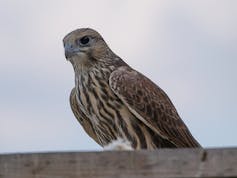Falcons are found worldwide, from the fast and slick hobbies to the large and powerful gyrfalcon of the Arctic tundra. In Africa, falcons are found across many habitats. Several species are unique to the continent, including the endangered Taita falcon, which nests on high cliffs, and the greater kestrel, which breeds in the old nests of other species, particularly crows.
There are 39 species of falcon in the world. They occur on all continents except Antarctica. Falcons belong to a group of unrelated birds called raptors (or birds of prey), which are distinguished mainly by their hooked beaks, keen eyesight and sharp talons.
Courtesy LtShears
As scientists studying falcons, we have always been fascinated by the dramatic dark stripes beneath their eyes (malar stripes).
These eye markings don’t just define their look – they’ve long been thought to act like natural sunglasses, reducing the amount of sun glare reflected into their eyes and thus improving their ability to hunt in bright sunlight.
This idea may also sound familiar to sports fans. Athletes in baseball and American football often smear dark stripes, known as “eye black”, under their eyes to enhance their vision in bright conditions. Scientific studies show that this can improve contrast sensitivity and reduce glare, providing a critical advantage for athletes tracking fast-moving balls. Could it be that nature perfected this innovation long before humans caught on?
In 2021, we published a paper providing evidence that this “natural eye black” might help peregrine falcons, the most widespread raptor species, to spot and hunt prey in sunny environments. But in our new paper, we reveal a more complex story – one where these markings may play other roles across different falcon species.
Studying peregrine falcons
Using over 2,000 photos of peregrine falcons submitted by birdwatchers around the globe, our earlier study tested the “solar glare hypothesis” by investigating whether peregrines living in brighter environments had larger or darker malar stripes. For each photo we assessed the size (length and width) and darkness of each falcon’s malar stripe. We also described the direction in which the bird was posing in case this had an effect on the malar stripe’s appearance. We then linked the location of each photo to a global dataset of solar radiation exposure.
This allowed us to estimate the level of solar radiation to which the birds in the photos were exposed, and to compared that with their malar stripes.
We found that peregrines living in sunnier regions, like Australia, had larger and darker malar stripes than those in areas with less sunlight, like Scotland. The findings supported the idea that these markings evolved as an adaptation to bright, sunny environments and work to shield the falcons’ eyes from glare, giving them a better chance of spotting and catching prey mid-flight.
Read more:
A dangerous pesticide isn’t being monitored in key bird of prey populations – we’re shedding light on that gap
This was the first empirical support for a hypothesis that had long been part of popular ornithological (bird) lore, and often taught to undergraduates, but had never been rigorously tested. Peregrines, the fastest species in the world, hunt agile birds like pigeons and doves, and therefore rely heavily on precise vision. Thus, the idea that their malar stripes could work to enhance this ability made evolutionary sense.
What about other falcons?
Inspired by these findings, we set out to explore whether the same pattern applied to other falcon species. We used over 10,000 images of 39 falcon species collected from citizen science platforms, including the Macaulay Library. Surprisingly, this larger study challenged our earlier assumptions.
We again linked the solar radiation levels experienced by the falcons in different locations to the size and darkness of their malar stripes. Contrary to what we observed in peregrines, for these other species the size of their malar stripe was unrelated to the level of sunlight exposure. In our new analysis, peregrines still showed a clear connection between brighter environments and darker stripes. But this was not the case for their relatives. We also didn’t find an overall pattern of species living in sunnier regions like Africa having larger and darker malar stripes. In fact, some African species, like the Dickinson’s kestrel, had no malar stripes at all.
Read more:
An Indian village went from hunting Amur falcons to being their biggest protectors. Here’s how conservationists can harness the power of persuasion
Our findings supported the opinions of previous research which also pointed out inconsistencies with the solar glare hypothesis. It was noted that many desert falcons, like the Saker falcon, have relatively small or inconspicuous malar stripes.

Сергей Неклюдов
So, why the stripes?
These results suggest that malar stripes may serve different purposes depending on the species. For peregrines, the solar glare hypothesis still seems to hold up. But for other falcons, these markings might play roles unrelated to sunlight. Perhaps they help to camouflage the falcon’s eyes from prey or act as social signals to other falcons.
This variability underscores the complexity of evolution. Just as athletes in different sports wear specialised gear, falcons’ malar stripes may have developed in accordance with the unique challenges of their environments and lifestyles. The stripes are not a one-size-fits-all solution but reflect the diversity of adaptation.
Citizen science
Peregrines remain the poster child for the solar glare hypothesis. But our findings remind us of the need to not assume that relationships in one species hold true for others. Future research could test these ideas experimentally or delve into the social and ecological functions of malar stripes in other falcon species.
We hope that citizen scientists and their photos can still play a key role in these efforts. Without their data, we could not have undertaken this research. Such photos are playing an increasingly useful role in understanding the ecology and evolution of raptors, with recent studies using photos to examine raptor diet at unprecedented scales.
If you’re interested in supporting raptor research, consider uploading your raptor photos to citizen science platforms like eBird or iNaturalist. Your observations could help unlock new discoveries about these remarkable birds.




















Discussion about this post